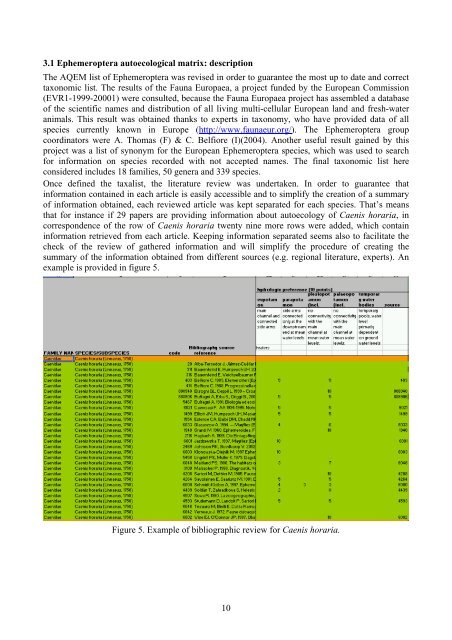Deliverable No. 189 Indicator value database for Ephemeroptera ...
Deliverable No. 189 Indicator value database for Ephemeroptera ...
Deliverable No. 189 Indicator value database for Ephemeroptera ...
You also want an ePaper? Increase the reach of your titles
YUMPU automatically turns print PDFs into web optimized ePapers that Google loves.
3.1 <strong>Ephemeroptera</strong> autoecological matrix: description<br />
The AQEM list of <strong>Ephemeroptera</strong> was revised in order to guarantee the most up to date and correct<br />
taxonomic list. The results of the Fauna Europaea, a project funded by the European Commission<br />
(EVR1-1999-20001) were consulted, because the Fauna Europaea project has assembled a <strong>database</strong><br />
of the scientific names and distribution of all living multi-cellular European land and fresh-water<br />
animals. This result was obtained thanks to experts in taxonomy, who have provided data of all<br />
species currently known in Europe (http://www.faunaeur.org/). The <strong>Ephemeroptera</strong> group<br />
coordinators were A. Thomas (F) & C. Belfiore (I)(2004). Another useful result gained by this<br />
project was a list of synonym <strong>for</strong> the European <strong>Ephemeroptera</strong> species, which was used to search<br />
<strong>for</strong> in<strong>for</strong>mation on species recorded with not accepted names. The final taxonomic list here<br />
considered includes 18 families, 50 genera and 339 species.<br />
Once defined the taxalist, the literature review was undertaken. In order to guarantee that<br />
in<strong>for</strong>mation contained in each article is easily accessible and to simplify the creation of a summary<br />
of in<strong>for</strong>mation obtained, each reviewed article was kept separated <strong>for</strong> each species. That’s means<br />
that <strong>for</strong> instance if 29 papers are providing in<strong>for</strong>mation about autoecology of Caenis horaria, in<br />
correspondence of the row of Caenis horaria twenty nine more rows were added, which contain<br />
in<strong>for</strong>mation retrieved from each article. Keeping in<strong>for</strong>mation separated seems also to facilitate the<br />
check of the review of gathered in<strong>for</strong>mation and will simplify the procedure of creating the<br />
summary of the in<strong>for</strong>mation obtained from different sources (e.g. regional literature, experts). An<br />
example is provided in figure 5.<br />
Figure 5. Example of bibliographic review <strong>for</strong> Caenis horaria.<br />
10

















